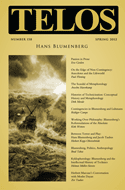Helmut Müller-Sievers’s “Kyklophorology: Hans Blumenberg and the Intellectual History of Technics” appears in Telos 158 (Spring 2012). Read the full version online at the TELOS Online website, or purchase a print copy of the issue here.
 This essay seeks to identify the elements in Hans Blumenberg’s work that could constitute an “intellectual history of technics” (Geistesgeschichte der Technik). While examples of Blumenberg’s deep engagement with technological discovery and artifacts can be found throughout his oeuvre, his project of counterbalancing metaphorology, conceived as technological history of the intellect (Technikgeschichte des Geistes), never came to systematic fruition. Unlike theological and philosophical language, which confronts the “absolutism of reality” with a surplus of metaphors, technics, in Blumenberg’s estimation, has remained mute to the present day. The Genesis of the Copernican World (1975) comes closest to identifying the “essence of technics” in the divergence between orbital motion of the planets and axial rotation of the earth. Axial rotation is unnatural, technical motion, as it requires for its induction the convergence of two oppositional forces on an extended body; only machines within a fixed frame are able to impart such forces. And yet the history of cosmology and technology consistently elides the difference between orbital motion and axial rotation—and thus parallels the elision of the difference between metaphors and concepts. Just as metaphorology seeks to write the history of this difference, kyklophorology seeks to open technical artifacts to historical and philosophical interpretation.
This essay seeks to identify the elements in Hans Blumenberg’s work that could constitute an “intellectual history of technics” (Geistesgeschichte der Technik). While examples of Blumenberg’s deep engagement with technological discovery and artifacts can be found throughout his oeuvre, his project of counterbalancing metaphorology, conceived as technological history of the intellect (Technikgeschichte des Geistes), never came to systematic fruition. Unlike theological and philosophical language, which confronts the “absolutism of reality” with a surplus of metaphors, technics, in Blumenberg’s estimation, has remained mute to the present day. The Genesis of the Copernican World (1975) comes closest to identifying the “essence of technics” in the divergence between orbital motion of the planets and axial rotation of the earth. Axial rotation is unnatural, technical motion, as it requires for its induction the convergence of two oppositional forces on an extended body; only machines within a fixed frame are able to impart such forces. And yet the history of cosmology and technology consistently elides the difference between orbital motion and axial rotation—and thus parallels the elision of the difference between metaphors and concepts. Just as metaphorology seeks to write the history of this difference, kyklophorology seeks to open technical artifacts to historical and philosophical interpretation.



